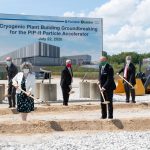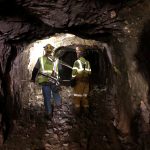All summer long, progress on preparing the Fermilab site for the construction of the Long-Baseline Neutrino Facility has been proceeding at a healthy clip. Now, as summer winds down, that site prep is nearing completion.
Long-Baseline Neutrino Facility
From Science, Oct. 2, 2020: As U.S. particle physicists start to drum up new ideas for the next decade in a yearlong Snowmass process they have no single big project to push for (or against). Physicists have just started to build the current plan’s centerpiece: The Long-Baseline Neutrino Facility at Fermilab will shoot particles through 1,300 kilometers of rock to the Deep Underground Neutrino Experiment in South Dakota. Fermilab Deputy Director of Research Joe Lykken and Fermilab scientist Vladimir Shiltsev comment on other possible pursuits in high-energy physics.
From Rapid City Journal, Aug. 6, 2020: Crews have begun installing a rock conveyor over U.S. Highway 85 in Lead, South Dakota, for the Long-Baseline Neutrino Facility. The conveyor will bring 800,000 tons of rock from the 4850 level of Sanford Underground Research Facility and deposit them into an open pit mining area that was excavated by the Homestake Gold Mine in the 1980s, making way for the international Deep Underground Neutrino Experiment, hosted by Fermilab.
From Sanford Underground Research Facility, Aug. 4, 2020: The most publicly visible milestone of the Long-Baseline Neutrino Facility’s pre-excavation work, a conveyor system, now extends over U.S. Highway 85 in Lead, South Dakota. Installation of the conveyor is one of a series of infrastructure strengthening projects undertaken to prepare the Sanford Underground Research Facility for its role as LBNF’s far site. Such projects lay the groundwork for the Deep Underground Neutrino Experiment, the most ambitious particle physics experiment on U.S. soil, hosted by Fermilab.
From Black Hills Pioneer, July 22, 2020: Since late 2019, work has been underway on the Long-Baseline Neutrino Facility conveyor system at the Sanford Underground Research Facility in South Dakota. The system will carry more than 800,000 tons of rock excavated from the site of the international, Fermilab-hosted Deep Underground Neutrino Experiment 4,850-feet below the surface. A major milestone for the project was met on July 20 as the 120-foot section of the truss, which will house the conveyor, was erected above the highway.
From Science, July 7, 2020: Spending panels in the U.S. House of Representatives have begun voting on bills to fund the government, and a few of them made use of an emergency mechanism to beef up research budgets. The national laboratories funded by the Department of Energy’s Office of Science is a big winner, receiving a one-time boost of $6.25 billion next year under a plan approved by a House spending panel, including funding for the Long-Baseline Neutrino Facility hosted by Fermilab.
Construction workers have carried out the first underground blasting for the Long-Baseline Neutrino Facility, which will provide the space, infrastructure and particle beam for the international Deep Underground Neutrino Experiment. This prep work paves the way for removing more than 800,000 tons of rock to make space for the gigantic DUNE detector a mile underground.
From Gizmodo, May 18, 2020: Neutrino physics is a trek into the unknown, one that the United States physics community has chosen to pursue full-on. A flagship experiment called LBNF/DUNE will lead the search, in pursuit of answers that may take decades or more to find. Fermilab Deputy Director for Research Joe Lykken, DUNE spokesperson Ed Blucher, and DUNE scientists Chang Kee Jung and Elizabeth Worcester talk about how neutrinos will enhance our understanding of the universe.
From the University of Bern, May 2020: The University of Bern and Fermilab partner on three neutrino projects aimed at a thorough study of some postulated properties of the ghostly particle: MicroBooNE, SBND and the Deep Underground Neutrino Experiment, the latter to be considered the world’s ultimate neutrino observatory.


